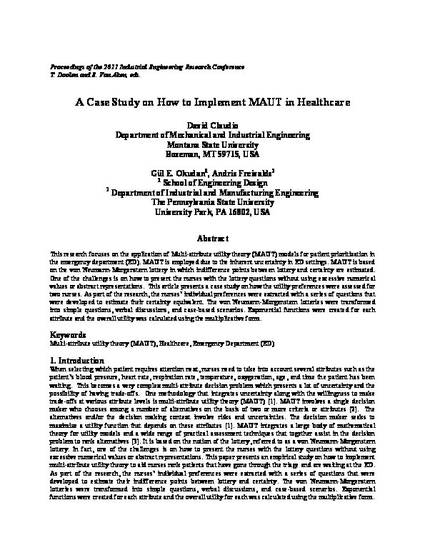
Presentation
A Case Study on How to Implement MAUT in Healthcare
IIE Annual Conference
(2011)
Abstract
This research focuses on the application of Multi-attribute utility theory (MAUT) models for patient prioritization in
the emergency department (ED). MAUT is employed due to the inherent uncertainty in ED settings. MAUT is based on the von Neumann-Morgenstern lottery in which indifference points between lottery and certainty are estimated. One of the challenges is on how to present the nurses with the lottery questions without using excessive numerical values or abstract representations. This article presents a case study on how the utility preferences were assessed for two nurses. As part of the research, the nurses’ individual preferences were extracted with a series of questions that were developed to estimate their certainty equivalent. The von Neumann-Morgenstern lotteries were transformed into simple questions, verbal discussions, and case-based scenarios. Exponential functions were created for each attribute and the overall utility was calculated using the multiplicative form.
Keywords
- Multi-attribute utility theory (MAUT),
- Healthcare,
- Emergency Department (ED)
Disciplines
Publication Date
2011
Comments
This is a proceeding published as Claudio, David, Gül E. Okudan, and Andris Freivalds. "A case study on how to implement MAUT in healthcare." In IIE Annual Conference. Proceedings, p. 1. Institute of Industrial and Systems Engineers (IISE), 2011. Posted with permission.
Citation Information
David Claudio, Gül E. Kremer and Andris Freivalds. "A Case Study on How to Implement MAUT in Healthcare" IIE Annual Conference (2011) Available at: http://works.bepress.com/gul-kremer/148/
